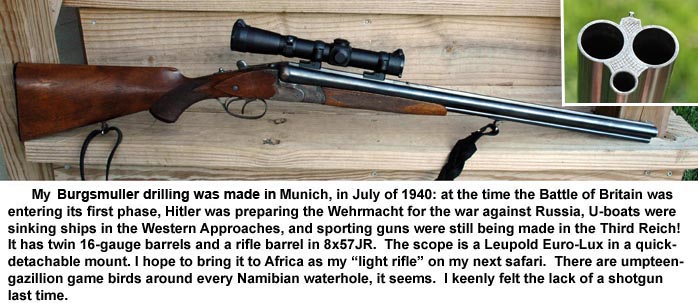
There are innumerable game birds in Africa, but last time I went on safari I didn't have a shotgun with me. Hence I wasn't able to get any wingshooting in, thanks to not planning ahead. I decided to remedy this deficiency in my "African battery" with a lovely drilling I bought from Cabela's.

It was made by H. Burgsmuller & Sohn in 1940, and surely must have come to the US as some GI's war souvenir. It isn't fancy, being the sort of plain-vanilla gun a prosperous middle-class merchant might have owned, but it's tight and accurate. It filled that "hole" nicely.
It has two 16-gauge shotgun barrels surmounting a rifle barrel in 8x57JRS, the rimmed version of the 8x57 Mauser. I had used my 8x57 Husqvarna with great success in 2010, so this gun will fill the "light rifle" role as well as enabling me to take advantage of the game bird populations. I've modified it a bit: the stock has been shortened to fit me, the chambers lengthened to 2-3/4" (just try finding 2-1/2" 16 gauge ammunition in Namibia!) and it's been fitted with a Leupold "Euro-Lux" scope in detachable guaranteed-to-return-to-zero mounts. The rifle barrel will shoot 1 MOA groups if you let it cool between shots, far better than I would have predicted.
I'm not a superstitious person, not really; but I do have this notion that it's not a good idea to take a gun to Africa unless I've made a kill with it. Since I hadn't managed to kill a deer with the drilling I took advantage of an opportunity that arose to put a few (metaphorical) notches in the gun.
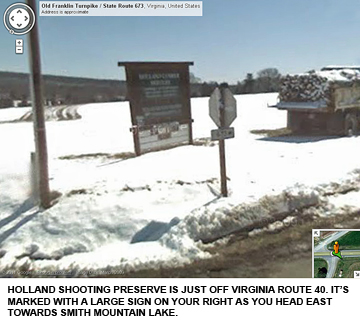 I had received a flyer from Summit
Springs Shooting Sports and Holland Shooting Preserve (no website, but they're at 365 Jacks Mountain Road, Glade Hill, just off Route 40. Phone is (540) 420-2168). The flyer was advertising a "Clays
and Quail" event. It was a combined half-day shoot on
put-and-take quail and a round of sporting clays, for a reasonable fee.
I had received a flyer from Summit
Springs Shooting Sports and Holland Shooting Preserve (no website, but they're at 365 Jacks Mountain Road, Glade Hill, just off Route 40. Phone is (540) 420-2168). The flyer was advertising a "Clays
and Quail" event. It was a combined half-day shoot on
put-and-take quail and a round of sporting clays, for a reasonable fee.
Around here the only wild birds to
shoot are doves (if you can find any) and turkeys, which are hunted like deer.
Wingshooting in the classic sense isn't much of a deal in Montgomery County and
environs. I have deep-rooted
philosophical objections to the concept of paying "lease fees" to 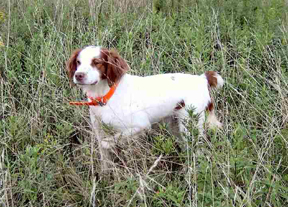 hunt native game, and would never pay anyone to hunt deer; but pen-raised birds
count as "livestock" in my book since they're legally the property of the preserve owner (which deer aren't and can't be). If I were going to do any wingshooting it would have to be on put-and-take birds.
hunt native game, and would never pay anyone to hunt deer; but pen-raised birds
count as "livestock" in my book since they're legally the property of the preserve owner (which deer aren't and can't be). If I were going to do any wingshooting it would have to be on put-and-take birds.
I went with my friend and colleague Phil and with Mac, the husband of another colleague. I had never before hunted over dogs, but Holland provided a guide and trained dogs in the price. These were three hard-charging Brittanies with inexhaustible energy and infallible noses.
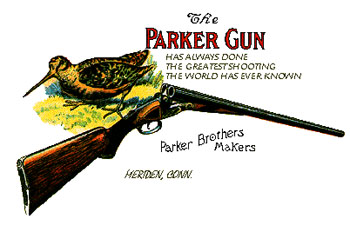 It's a 2-hour drive from Blacksburg so we got an early start, signed in with the preserve owner, John Holland, and met our guide, Brian. Brian unloaded two of his dogs at the shoot
site about 8:40 AM and they immediately started bouncing around and sniffing. Phil was using a 12 gauge
Browning Auto-5, and Mac a phenomenally beautiful Parker in 28 gauge.
I had to be very careful not to drool on the Parker, which not only was a 28
gauge, it had selective ejectors. God knows what he spent for it, but it
was worth the price just to look at, let alone shoot. If Catherine Zeta-Jones were a shotgun, I think that's the one she would be.
It's a 2-hour drive from Blacksburg so we got an early start, signed in with the preserve owner, John Holland, and met our guide, Brian. Brian unloaded two of his dogs at the shoot
site about 8:40 AM and they immediately started bouncing around and sniffing. Phil was using a 12 gauge
Browning Auto-5, and Mac a phenomenally beautiful Parker in 28 gauge.
I had to be very careful not to drool on the Parker, which not only was a 28
gauge, it had selective ejectors. God knows what he spent for it, but it
was worth the price just to look at, let alone shoot. If Catherine Zeta-Jones were a shotgun, I think that's the one she would be.
The drilling is choked very tightly. I'm not sure exactly how to rate the chokes but with a micrometer they seemed to be Full and Extra Full. Since in Europe drillings traditionally are used on anything that comes along and since buckshot and slugs are par for the course, tight chokes seem to be the rule on them. Then, too, in 1940 shotshells didn’t use plastic cup wads. Modern shells that have them pattern more tightly from any degree of choke compared to the older paper-hulled ones that lack any sort of shot buffer or protective collar. A gun bored Improved Cylinder and Modified is supposed to be ideal for this sort of game, but what I have, I have. I had neither the time nor the inclination to have the chokes opened up, so I took it as it was; though of course I dismounted the scope.
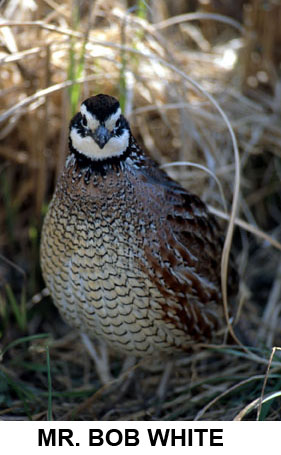
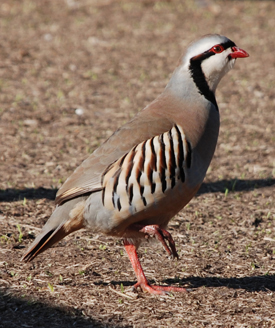 Things went pretty well. I actually made the first kill: the dogs put up a chukar and I fired
more or less instinctively and nailed him good and hard. Over the course of the
shoot I managed to hit several quail, and at least one more chukar. Sometimes
things were happening so fast I lost track, but the three of us racked up a total of
36 quail and 4 chukars. We'd paid for 12 quail apiece, and got them all.
Things went pretty well. I actually made the first kill: the dogs put up a chukar and I fired
more or less instinctively and nailed him good and hard. Over the course of the
shoot I managed to hit several quail, and at least one more chukar. Sometimes
things were happening so fast I lost track, but the three of us racked up a total of
36 quail and 4 chukars. We'd paid for 12 quail apiece, and got them all.
Mac is a heck of a wingshot, and that 28 of his seems to be a Bird Death Ray. But I do modestly claim to have made The Shot Of The Day, a quail jinking and dodging through the trees like a grouse. I neatly dumped him, stone dead, from 30-35 yards. I'm certain I killed at least 7 quail, perhaps a few more; and two chukars. This is not bad for a guy whose last experience with wingshooting was 10 years ago on barn pigeons.
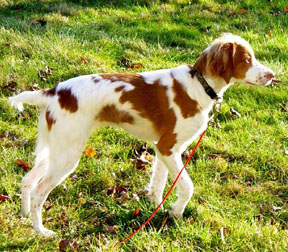 The dogs were amazing and as I'd never hunted over dogs before, they were a revelation. They would be jumping around, seemingly at random, when suddenly one would freeze on a point. We'd walk up in a line (I usually took
the far right end of the line) and the guide would move up to the dog, who
was staring at the birds, frozen like a statue. The guide would kneel, tickle the bird
to make it fly, and BOOM-BOOM-BOOM, down he'd go (especially if he went up in front of Mac's Parker). Mac was incredibly
fast off the mark, and knocked his targets down stone dead in half
a second. After the shooting ended the dogs would go fetch the birds. A couple of times we weren't able to
find a downed bird, and the guide simply said, "Let's go bust up another
covey: we'll come back for it later." This seemed impossible to me, but
damned if those dogs didn't come back to the same pasture area half an hour
later and find every downed bird. The only birds that got away were one
chukar who managed to fly into a no-shooting area unscathed; and a second one
who never got detected, possibly because he had the good sense to move to the
next county as soon as he was released.
The dogs were amazing and as I'd never hunted over dogs before, they were a revelation. They would be jumping around, seemingly at random, when suddenly one would freeze on a point. We'd walk up in a line (I usually took
the far right end of the line) and the guide would move up to the dog, who
was staring at the birds, frozen like a statue. The guide would kneel, tickle the bird
to make it fly, and BOOM-BOOM-BOOM, down he'd go (especially if he went up in front of Mac's Parker). Mac was incredibly
fast off the mark, and knocked his targets down stone dead in half
a second. After the shooting ended the dogs would go fetch the birds. A couple of times we weren't able to
find a downed bird, and the guide simply said, "Let's go bust up another
covey: we'll come back for it later." This seemed impossible to me, but
damned if those dogs didn't come back to the same pasture area half an hour
later and find every downed bird. The only birds that got away were one
chukar who managed to fly into a no-shooting area unscathed; and a second one
who never got detected, possibly because he had the good sense to move to the
next county as soon as he was released.
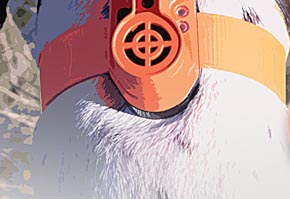 The dogs were fitted with special collars with speakers on them. Each dog's
collar had a distinctive BEEP! sound, so you could tell where he
was. This is needed because often they're invisible in the weeds. If the dog froze on a
point, immobility changed the sound to the scream of a hawk, which is supposed to freeze the
birds in place until the guide got there to make them fly.
The dogs were fitted with special collars with speakers on them. Each dog's
collar had a distinctive BEEP! sound, so you could tell where he
was. This is needed because often they're invisible in the weeds. If the dog froze on a
point, immobility changed the sound to the scream of a hawk, which is supposed to freeze the
birds in place until the guide got there to make them fly.
In all Brian had three dogs, two of them very experienced and one a 9-month old pup "in training." That pup had a nose like a heat-seeking missile. He was the one who found the downed birds: he'd been left in the dog box for the first half of the shoot, while the more experienced pair worked the field, but as soon as he was released he ran into the area where we'd been, and picked up on the scent of the dead birds immediately, fetching them back.
We did a second
shoot a few weeks later. That time I
brought along a pretty little 1920's-vintage Belgian hammer double in 20 gauge. I shot 7 quail and 2
chukar, but I had some "gun problems." It doubled on me at
least twice: on firing the right barrel the left went off, presumably from the
recoil jarring the sear out of its notch. It's at the gunsmith being
disciplined for its bad behavior.
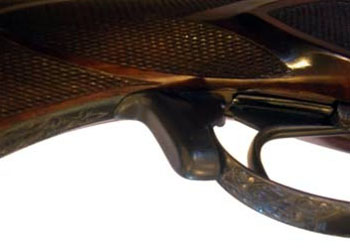 The other problem is that this gun (as well as the drilling)
beats the hell out of the middle finger on my right hand. The
trigger guard raps me on the knuckle, leaving it pretty swollen and red, and
more than a bit sore. I've had this problem in the past with a 12-gauge
double, which was MUCH worse: but I solved it on that gun by a modification to
the trigger guard. I can't do that on this gun nor on the drilling, the guards
aren't "bendable" the way the one on my 12 gauge is. I bought some soft rubber pads from
Connecticut Shotgun that clamp on the guard and are supposed to fix this: we’ll
see if they work.
The other problem is that this gun (as well as the drilling)
beats the hell out of the middle finger on my right hand. The
trigger guard raps me on the knuckle, leaving it pretty swollen and red, and
more than a bit sore. I've had this problem in the past with a 12-gauge
double, which was MUCH worse: but I solved it on that gun by a modification to
the trigger guard. I can't do that on this gun nor on the drilling, the guards
aren't "bendable" the way the one on my 12 gauge is. I bought some soft rubber pads from
Connecticut Shotgun that clamp on the guard and are supposed to fix this: we’ll
see if they work.
On the second trip the DOGS got four birds by themselves. They would hold a point 99% of the time but if the bird flushed close to them, BAM! they'd make a grab for it, and sometimes catch it. I was told by the dog handler this is permitted in field trials, which seems odd. I should think it would be a fault, but what do I know? Wild birds, I’m told, are far less willing to hold tight with a Brittany spaniel breathing on them.
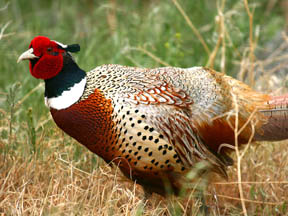 We have a third trip (the last for this season, alas) planned for a couple of days from now. This time we're going to try for some of John's ring-necked pheasants. I'll be bringing a 12 gauge double, last used when I was actively shooting pigeons.
We have a third trip (the last for this season, alas) planned for a couple of days from now. This time we're going to try for some of John's ring-necked pheasants. I'll be bringing a 12 gauge double, last used when I was actively shooting pigeons.
| HUNTING | GUNS | DOGS |
| FISHING & BOATING | TRIP REPORTS | MISCELLANEOUS ESSAYS |
| CONTRIBUTIONS FROM OTHER WRITERS|
| RECIPES |POLITICS |